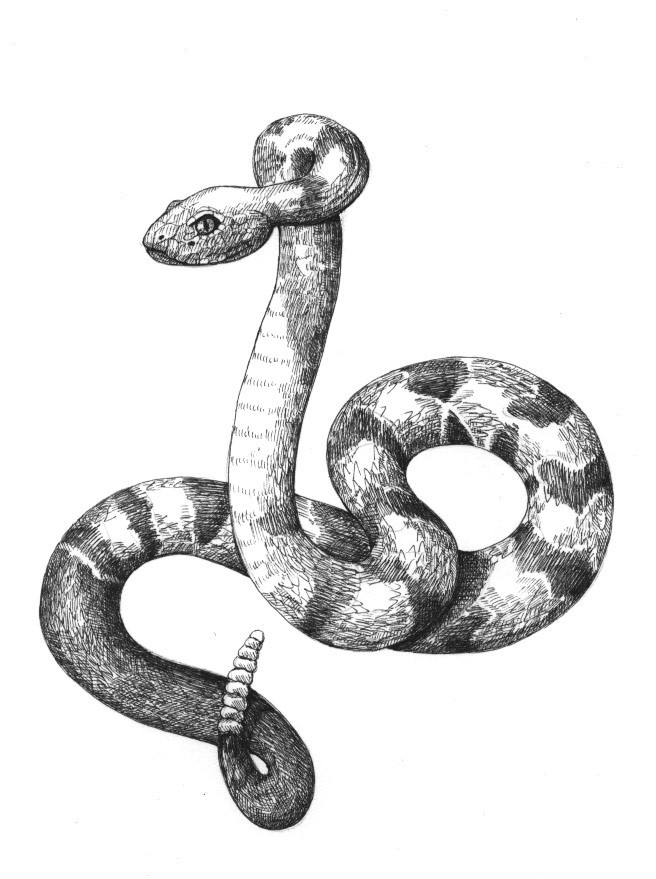
I am climbing through the brush with Alcott Smith, a veterinarian who spends more time in the woods than in the clinic, on a pilgrimage to one of the last extant rattlesnake ledges in Vermont. Yes, you read that correctly, rattlesnakes in Vermont. But of the more than twenty sites in Vermont that once supported rattlesnakes, I know of only three that still do. The last official sighting of a rattlesnake in the Connecticut River valley was on the slopes of Little Ascutney Mountain in the mid-1950s, though reports persist of snakes on the ledges above Boston Lot in West Lebanon, New Hampshire. I’ve never seen them there myself.
By the early years of the 21st century, we’ve made our peace with virtually every other North American beast: the owl and the eagle, the wolf and the catamount, the alligator and the crocodile, the silver-tip grizzly. Why not the timber rattlesnake? Why is this timid reptile still subjected to the same fear and loathing here in New England that brought down our region’s great predators?
During the 1979 legislative session, the State of New Hampshire passed a comprehensive bill to protect endangered and threatened vertebrates. I was on a team of naturalists asked to recommend to the Commissioner of Fish and Game which animals warranted inclusion on the state’s new endangered species list. After six hours of debating the relative merits of the more than 40 animals proposed for the list, we voted, using a point system that assigned numbers to various wildlife according to their degree of rarity and their scientific and scenic value.
Timber rattlesnakes received a rating of 25, two points higher than the arbitrary cutoff for threatened species and only 0.6 points lower than the rating given to peregrine falcons, the recipients of a multimillion-dollar, nationwide restoration effort. (At the time, peregrines were extinct in the Northeast.) Except for falcons and Atlantic salmon – another distinguished creature in the conservation limelight – timber rattlesnakes had the third highest ranking, higher than that of bald eagles, osprey, loons, even higher than lynx – which were on the verge of extinction in New Hampshire – and pine marten, which were then already gone. But at the insistence of Fish and Game Commissioner Charles Berry, the timber rattlesnake was axed from the final endangered species list submitted to the governor – to the chagrin of few.
For a timber rattlesnake to prosper in Vermont or New Hampshire, heat is essential. The number of frost-free days is not nearly as important as the number of days the snake’s body temperature is above 70 degrees Fahrenheit. If rattlesnakes were classified like garden vegetables, they would be Zone 4 reptiles growing in Zone 3. To carry this analogy one step further, if you wanted to grow them in your yard, you would have to start them indoors under lights, transfer them to a cold frame on the first of May, then plant them sometime after Memorial Day. They would be harder to start than melons, slower-growing than black walnuts, and like September basil, would need a blanket of newspaper at the first sign of frost.
In our region, timber rattlesnakes are living on the edge. They feed only 6 to 20 times per summer, mostly on white-footed mice and chipmunks. Although they may live for 30 years, females do not breed until at least their sixth year and bear only seven or eight young every third year. Once a hibernating site has been savaged by hunters or collectors – there is a lucrative black market for New England timber rattlesnakes – it takes decades for populations to rebuild. Sometimes they never do.
Back with Alcott Smith, the afternoon is warm, the sky cloudless. The ledges are already too hot for the rattlesnakes, which rest in the shade of slab awnings. The sweet song of a rose-breasted grosbeak pours from a chestnut oak. I settle on a ledge in the company of 11 snakes, as Alcott scouts for more. One is as thick around as my forearm and as dark as coal. Another is yellow, banded brown. Some have recently shed. Others appear ready to burst from their worn, dull outer skin. Two are mating, braided together like a living rope. Their bodies swell and contract in unison.
Not one rattlesnake seems concerned that I share the ledge with them. Forged from the furnace of another age, they stare out of the shadows with unblinking eyes, reading the world with senses that I cannot fathom.

